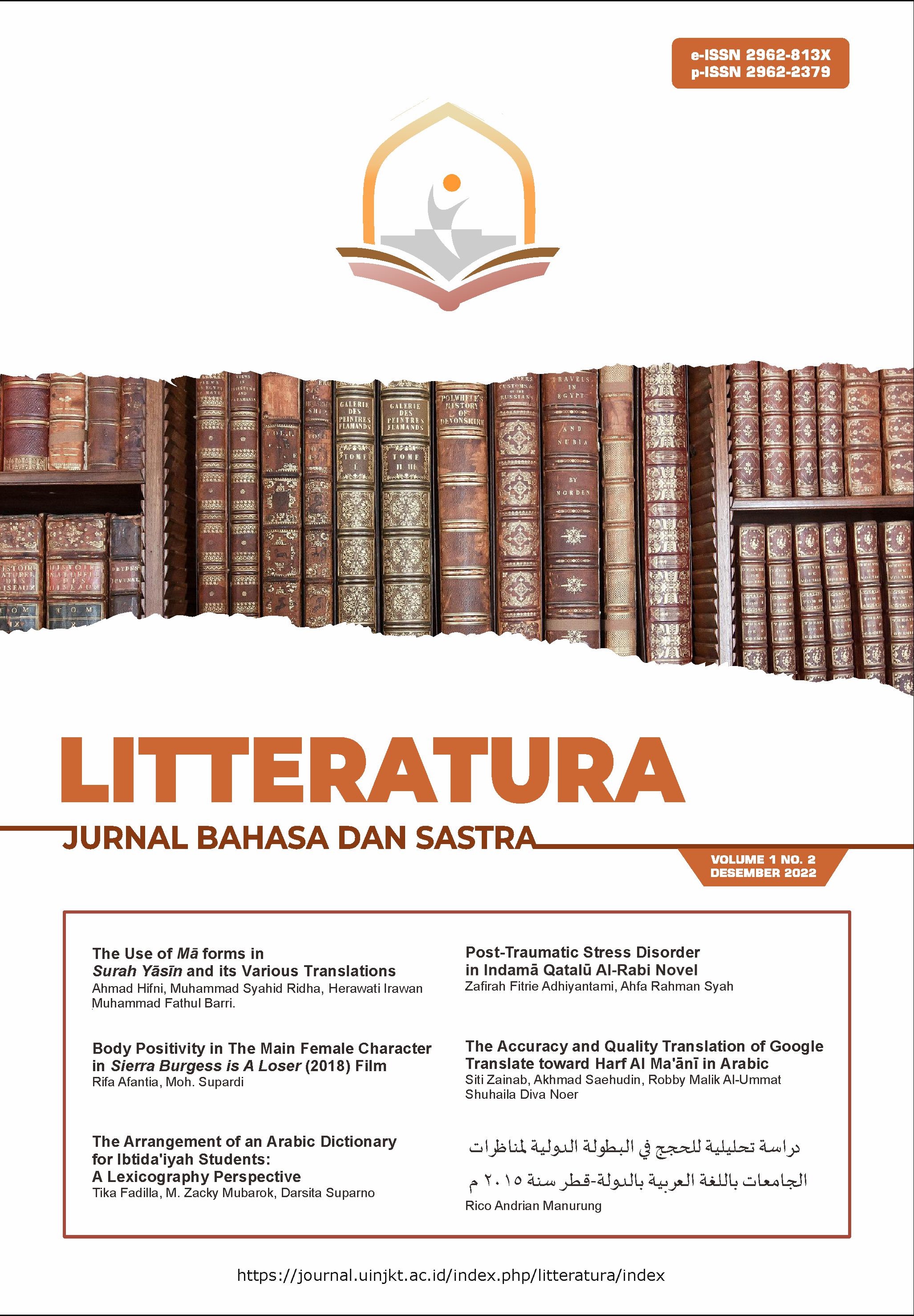Body Positivity in The Main Female Character in Sierra Burgess is A Loser (2018) Film
DOI:
https://doi.org/10.15408/ltr.v1i2.26182Keywords:
Beauty Standard, Body Image, Body Positivity, Feminism, Positive Body ImageAbstract
This research aims to explore the characterization of Sierra as the main female character reflecting body positivity presented in the Sierra Burgess Is a Loser (2018) film directed by Ian Samuels. This research uses the descriptive qualitative method supported by the character and characterization theory by Joseph M. Boggs and Dennis W. Petrie and representation theory by Stuart Hall. This research also uses the concept of body positivity by Tracy and Wood Barcalow to support the analysis. In the Sierra Burgess Is a Loser film, Sierra represents intelligence, independence, and confidence as a teenage girl who reflects body positivity. She struggles to achieve her freedom as a plus body size woman. Becasue of her plus body size, Sierra experiences injustice and bullying as a fat girl in her school. Sierra reflects body positivity as she fights to gain her confidence and face her fear through the struggles of being a fat girl. Moreover, it shows that Sierra Burgess Is a Loser (2018) film tries to support the body positivity movement as the film portrays Sierra as an intelligent woman who breaks the stereotype of unrealistic body image and manages to embrace other women to have a body positivity image.
References
Anderson, V., Miedema, B., & Stoppard, J. M. (Eds.). (2000). Women’s bodies/women’s lives: Health, well-being and body image. Sumach Press.
Bearman, S. K., Presnell, K., Martinez, E., & Stice, E. (2006). The Skinny on Body Dissatisfaction: A Longitudinal Study of Adolescent Girls and Boys. Journal of Youth and Adolescence, 35(2), 217–229. https://doi.org/10.1007/s10964-005-9010-9
Berscheid, E., Dion, K., Walster, E., & Walster, G. W. (1971). Physical attractiveness and dating choice: A test of the matching hypothesis. Journal of Experimental Social Psychology, 7(2), 173–189. https://doi.org/10.1016/0022-1031(71)90065-5
Bordo, S. (2013). Unbearable weight: Feminism, Western culture, and the body (10. anniversary ed., [Nachdr.]). Univ. of California Press.
Botta, R. A. (2000). The Mirror of Television: A Comparison of Black and White Adolescents’ Body Image. Journal of Communication, 50(3), 144–159. https://doi.org/10.1111/j.1460-2466.2000.tb02857.x
Crespo, C., Kielpikowski, M., Jose, P. E., & Pryor, J. (2010). Relationships Between Family Connectedness and Body Satisfaction: A Longitudinal Study of Adolescent Girls and Boys. Journal of Youth and Adolescence, 39(12), 1392–1401. https://doi.org/10.1007/s10964-009-9433-9
Dake, J. A., Price, J. H., & Telljohann, S. K. (2003). The Nature and Extent of Bullying at School. Journal of School Health, 73(5), 173–180. https://doi.org/10.1111/j.1746-1561.2003.tb03599.x
Darwin, H., & Miller, A. (2020). Factions, frames, and postfeminism(s) in the Body Positive Movement. Feminist Media Studies, 1–18. https://doi.org/10.1080/14680777.2020.1736118
Denzin, N. K., & Lincoln, Y. S. (Eds.). (2011). The Sage handbook of qualitative research (4th ed). Sage.
Dion, K., Berscheid, E., & Walster, E. (1972). What is beautiful is good. Journal of Personality and Social Psychology, 24(3), 285–290. https://doi.org/10.1037/h0033731
Field, A. E. (2005). Exposure to the Mass Media, Body Shape Concerns, and Use of Supplements to Improve Weight and Shape Among Male and Female Adolescents. PEDIATRICS, 116(2), e214–e220. https://doi.org/10.1542/peds.2004-2022
Fredrickson, B. L., & Roberts, T.-A. (1997). Objectification Theory: Toward Understanding Women’s Lived Experiences and Mental Health Risks. Psychology of Women Quarterly, 21(2), 173–206. https://doi.org/10.1111/j.1471-6402.1997.tb00108.x
Gill, R. (2007). Postfeminist media culture: Elements of a sensibility. European Journal of Cultural Studies, 10(2), 147–166. https://doi.org/10.1177/1367549407075898
Grogan, S. (2010). Promoting Positive Body Image in Males and Females: Contemporary Issues and Future Directions. Sex Roles, 63(9–10), 757–765. https://doi.org/10.1007/s11199-010-9894-z
Hall, S. (Ed.). (1997). Representation: Cultural representations and signifying practices. Sage in association with the Open University.
Halliwell, E. (2015). Future directions for positive body image research. Body Image, 14, 177–189. https://doi.org/10.1016/j.bodyim.2015.03.003
Jago, C., Shea, R. H., Scanlon, L., & Aufses, R. D. (2011). Literature & composition: Reading, writing, thinking.
Makowski, A. C., Mnich, E. E., Angermeyer, M. C., Löwe, B., & von dem Knesebeck, O. (2015). Sex differences in attitudes towards females with eating disorders. Eating Behaviors, 16, 78–83. https://doi.org/10.1016/j.eatbeh.2014.10.017
Menzel, J. E., & Levine, M. P. (2011). Embodying experiences and the promotion of positive body image: The example of competitive athletics. In R. M. Calogero, S. Tantleff-Dunn, & J. K. Thompson (Eds.), Self-objectification in women: Causes, consequences, and counteractions. (pp. 163–186). American Psychological Association. https://doi.org/10.1037/12304-008
Miller, A. G. (1970). Role of physical attractiveness in impression formation. Psychonomic Science, 19(4), 241–243. https://doi.org/10.3758/BF03328797
Peterson, R. D., Tantleff-Dunn, S., & Bedwell, J. S. (2006). The effects of exposure to feminist ideology on women’s body image. Body Image, 3(3), 237–246. https://doi.org/10.1016/j.bodyim.2006.05.004
Petrie, D. W., & Boggs, J. M. (2018). The art of watching films (Ninth edition). McGraw-Hill Education.
Reis, H. T., Nezlek, J., & Wheeler, L. (1980). Physical attractiveness in social interaction. Journal of Personality and Social Psychology, 38(4), 604–617. https://doi.org/10.1037/0022-3514.38.4.604
Samuels, I. (2018, September 7). Sierra Burgess Is A Loser [Romantic Comedy]. Netflix. https://www.netflix.com/id/title/80239639
Sastre, A. (2014). Towards a Radical Body Positive: Reading the online “body positive movement.” Feminist Media Studies, 14(6), 929–943. https://doi.org/10.1080/14680777.2014.883420
Solomon, M. R., Ashmore, R. D., & Longo, L. C. (1992). The Beauty Match-Up Hypothesis: Congruence between Types of Beauty and Product Images in Advertising. Journal of Advertising, 21(4), 23–34. https://doi.org/10.1080/00913367.1992.10673383
Thompson, J. K., & Stice, E. (2001). Thin-Ideal Internalization: Mounting Evidence for a New Risk Factor for Body-Image Disturbance and Eating Pathology. Current Directions in Psychological Science, 10(5), 181–183. https://doi.org/10.1111/1467-8721.00144
Tylka, T. L., & Wood-Barcalow, N. L. (2015a). What is and what is not positive body image? Conceptual foundations and construct definition. Body Image, 14, 118–129. https://doi.org/10.1016/j.bodyim.2015.04.001
Tylka, T. L., & Wood-Barcalow, N. L. (2015b). What is and what is not positive body image? Conceptual foundations and construct definition. Body Image, 14, 118–129. https://doi.org/10.1016/j.bodyim.2015.04.001
Unger, R. K. (1979). Toward a redefinition of sex and gender. American Psychologist, 34(11), 1085–1094. https://doi.org/10.1037/0003-066X.34.11.1085


